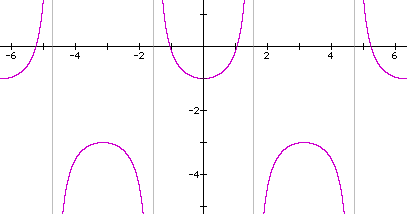

Objectives: To determine the properties of the secant and cosecant functions; to graph the secant and cosecant functions.
I. First, let's set up and examine a table of the coordinates of some of the points that will satisfy the equation y = secx.
1. Open an Excel spreadsheet. Label column A "x-coordinates," column B "y-coordinates of cosine," and column C "y-coordinates of secant." Set all three columns to round to 4 decimal places.
2. Fill in your x-coordinates in column A by ranging from -2p to 2p by increments of p/ 4. Remember, x represents an angular measure - we're using radians as our units.
3. Fill in your y-coordinates in column B by utilizing the equation, y = cosx.
4. Fill in your y-coordinates in column C by utilitzing the relationship between cosine and secant.
What do you notice about the values in this column? What does the ##### mean? How do the values in columns B and C relate? Can you predict what the graph will look like?
II. Graphing in Graphing Calculator.
1. Graph y = cosx from -2p to 2p.
2. On the same coordinate plane (but in a different color), graph y = secx from -2p to 2p.
3. Explain what the vertical lines on the graph represent.
4. What is the length of one period of y = secx?
5. Do secant graphs have "amplitude?" Why or why not?
6. How do the graphs of y = cosx and y = secx relate?
III. Check yourself.
Sketch (by hand!) what the graph of y = secx will look like, given the following domain restrictions. Be careful about where the maximums, minimums, and asymptotes are.
a) 2p to 4p
b) -4p to 0
c) -3p/2 to p/2
I.
2. In cell A2, type in "=-2*pi()". In cell A3, type in "=A2+pi()/ 4". Drag to fill down to row 18.
3. In cell B2, type in "=cos(A2)". Drag to fill down to row 18.
4. In cell C2, type in "=1/B2". Drag to fill down to row 18.
Here is a sample table:
| x-coordinates | y-coordinates for cosine | y-coordinates for secant |
| -6.2832 | 1 | 1 |
| -5.4978 | 0.7071 | 1.4142 |
| -4.7124 | 0 | ##### |
| -3.9270 | -0.7071 | -1.4142 |
| -3.1416 | -1 | -1 |
| -2.3562 | -0.7071 | -1.4142 |
| -1.5708 | 0 | ##### |
| -0.7854 | 0.7071 | 1.4142 |
| 0 | 1 | 1 |
| 0.7854 | 0.7071 | 1.4142 |
| 1.5708 | 0 | ##### |
| 2.3562 | -0.7071 | -1.4142 |
| 3.1416 | -1 | -1 |
| 3.9270 | -0.7071 | -1.4142 |
| 4.7124 | 0 | ##### |
| 5.4978 | 0.7071 | 1.4142 |
| 6.2832 | 1 | 1 |
Answers: The values in column C repeat. The ##### means "undefined." The values in columns B and C are reciprocals of each other.
II.
2. Here is a sample graph (y = cosx in blue and y = secx in green):
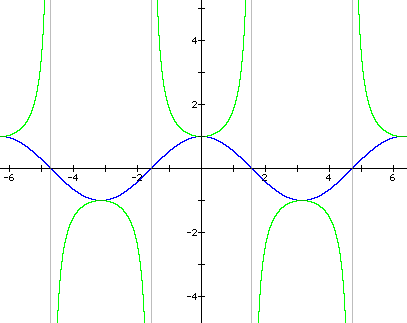
3. The vertical lines are asymptotes of the graph.
4. One period = 2p.
5. No. Secant graphs go on forever in vertical directions, so they cannot have a "height."
6. The maximum and minimum points, respectively, of y = cosx and of the "pieces" of y = secx are the same. The x-intercepts of y = cosx become asymptotes for y = secx.
III.
a)
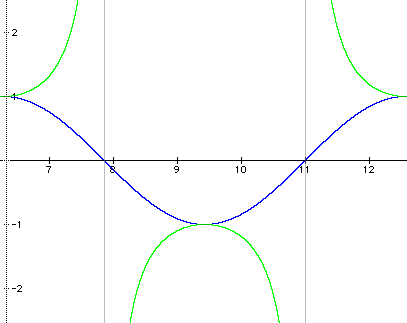
b)
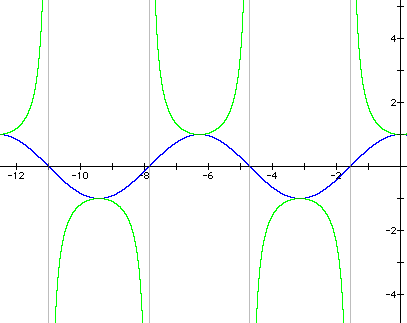
c)

I. First, let's set up and examine a table of the coordinates of some of the points that will satisfy the equation y = cscx.
1. Open an Excel spreadsheet. Label column A "x-coordinates," column B "y-coordinates of sine," and column C "y-coordinates of cosecant." Set all three columns to round to 4 decimal places.
2. Fill in your x-coordinates in column A by ranging from -2p to 2p by increments of p/ 4. Remember, x represents an angular measure - we're using radians as our units.
3. Fill in your y-coordinates in column B by utilizing the equation, y = sinx.
4. Fill in your y-coordinates in column C by utilitzing the relationship between sine and cosecant.
What do you notice about the values in this column? What does the ##### mean? How do the values in columns B and C relate? Can you predict what the graph will look like?
II. Graphing in Graphing Calculator.
1. Graph y = sinx from -2p to 2p.
2. On the same coordinate plane (but in a different color), graph y = cscx from -2p to 2p.
3. Explain what the vertical lines on the graph represent.
4. What is the length of one period of y = cscx?
5. Do cosecant graphs have "amplitude?" Why or why not?
6. How do the graphs of y = sinx and y = cscx relate?
III. Check yourself.
Sketch (by hand!) what the graph of y = cscx will look like, given the following domain restrictions. Be careful about where the maximums, minimums, and asymptotes are.
a) 2p to 4p
b) -4p to 0
c) -3p/2 to p/2
I.
2. In cell A2, type in "=-2*pi()". In cell A3, type in "=A2+pi()/ 4". Drag to fill down to row 18.
3. In cell B2, type in "=sin(A2)". Drag to fill down to row 18.
4. In cell C2, type in "=1/B2". Drag to fill down to row 18.
Here is a sample table:
| x-coordinates | y-coordinates for sine | y-coordinates for cosecant |
| -6.2832 | 0 | ##### |
| -5.4978 | 0.7071 | 1.4142 |
| -4.7124 | 1 | 1 |
| -3.9270 | 0.7071 | 1.4142 |
| -3.1416 | 0 | ##### |
| -2.3562 | -0.7071 | -1.4142 |
| -1.5708 | -1 | -1 |
| -0.7854 | -0.7071 | -1.4142 |
| 0 | 0 | ##### |
| 0.7854 | 0.7071 | 1.4142 |
| 1.5708 | 1 | 1 |
| 2.3562 | 0.7071 | 1.4142 |
| 3.1416 | 0 | ##### |
| 3.9270 | -0.7071 | -1.4142 |
| 4.7124 | -1 | -1 |
| 5.4978 | -0.7071 | -1.4142 |
| 6.2832 | 0 | ##### |
Answers: The values in column C repeat. The ##### means "undefined." The values in columns B and C are reciprocals of each other.
II.
2. Here is a sample graph (y = sinx is in red and y = cscx is in purple):
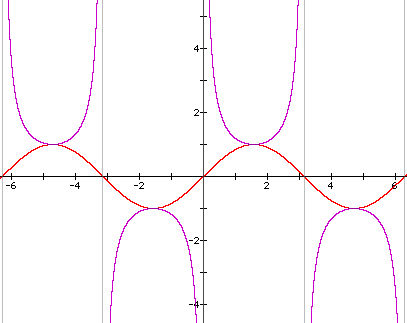
3. The vertical lines are asymptotes of the graph.
4. One period = 2p.
5. No. Cosecant graphs go on forever in vertical directions, so they cannot have a "height."
6. The maximum and minimum points, respectively, of y = sinx and of the "pieces" of y = cscx are the same. The x-intercepts of y = sinx become asymptotes for y = cscx.
III.
a)
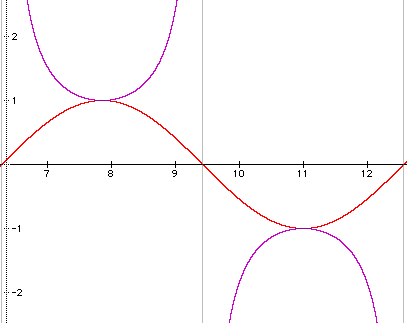
b)
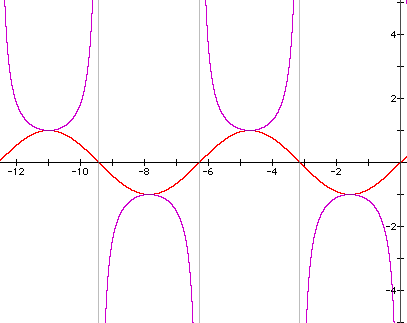
c)
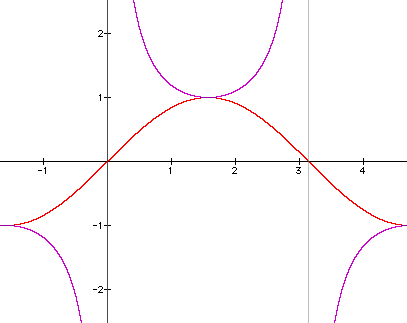
I. Using Graphing Calculator,
1. Graph y = secx and y = 2secx on the same coordinate plane (but in different colors).
2. Then graph y = cscx and y = -0.5cscx on the same coordinate plane (but in different colors).
Examine more graphs of this form if you find it necessary to be able to answer the following questions.
Answer the following questions about equations in the forms y = Asecx and y = Acscx:
a) What happens to the graph of y = secx and y = cscx when A > 1?
b) What happens when 0 < A < 1?
c) When -1 < A < 0?
d) What about when A = -1?
e) And when A < -1?
II. Using Graphing Calculator,
1. Graph y = secx and y = sec2x on the same coordinate plane (but in different colors).
2. Then graph y = cscx and y = csc0.5x on the same coordinate plane (but in different colors).
Examine more graphs of this form if you find it necessary to be able to answer the following questions.
Answer the following questions about equations in the forms y = secBx and y = cscBx:
a) What happens to the graphs of y = secx and y = cscx when B > 1?
b) What happens when 0 < B < 1?
c) When -1 < B < 0? Be careful!!
d) What about when B = -1? Be careful!!
e) And when B < -1? Be careful!!
f) How can you find the period of a function, given its equation?
III. Using Graphing Calculator,
1. Graph y = secx and y = sec(x - p/2) on the same coordinate plane (but in different colors).
2. Then graph y = cscx and y = csc(x + p/4) on the same coordinate plane (but in different colors).
Examine more graphs of this form if you find it necessary to be able to answer the following questions.
Answer the following questions about equations in the forms y = sec(x + C) and y = csc(x + C):
a) What happens to the graph of y = secx and y = cscx when C is positive?
b) What about when C is negative?
IV. Using Graphing Calculator,
1. Graph y = secx and y = secx + 2 on the same coordinate plane (but in different colors).
2. Then graph y = cscx and y = cscx - 1 on the same coordinate plane (but in different colors).
Examine more graphs of this form if you find it necessary to be able to answer the following questions.
Answer the following questions about equations in the forms y = secx + D and y = cscx + D:
a) What happens to the graphs of y = secx and y = cscx when D is positive?
b) What about when D is negative?
(Note: All y = tanx graphs are green and their paired graphs are red; all y = cotx graphs are purple and their paired graphs are blue)
I. Here are some sample graphs:
1.
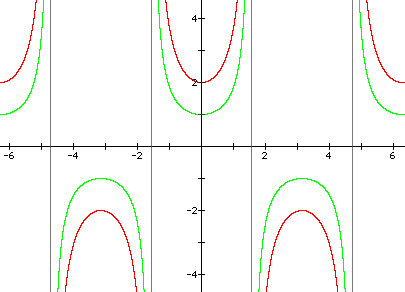
2.
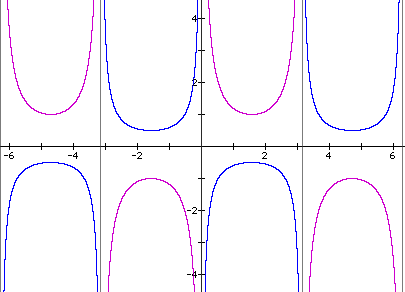
a) The graphs "stretch" away from the x-axis.
b) The graphs "shrink" toward the x-axis.
c) The graphs "flip" about the x-axis and "shrink" toward the x-axis.
d) The graphs "flip" about the x-axis.
e) The graphs "flip" about the x-axis and "stretch" away from the x-axis.
II. Here are some sample graphs:
1.
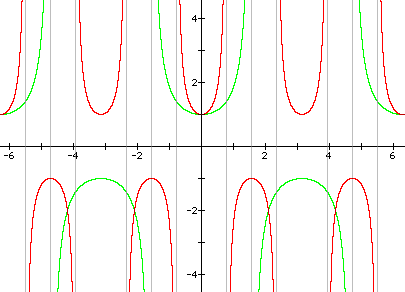
2.
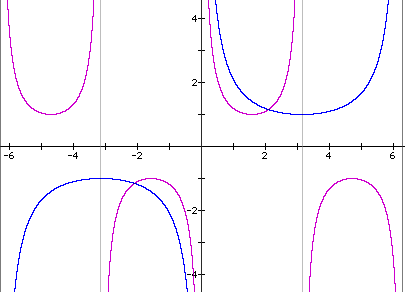
a) The graphs "squeeze" horizontally.
b) The graphs "stretch" horizontally.
c) For cosecent, the graphs "flip" about the x-axis and "stretch" horizontally. For secant, the graphs just "stretch" horizontally.
d) For cosecant, the graphs "flip" about the x-axis. For secant, the graphs remain the same.
e) For cosecant, the graphs "flip" about the x-axis and "squeeze" horizontally. For secant, the graphs just "stretch" horizontally.
f) Period = 2p/ | B |
III. Here are some sample graphs:
1.
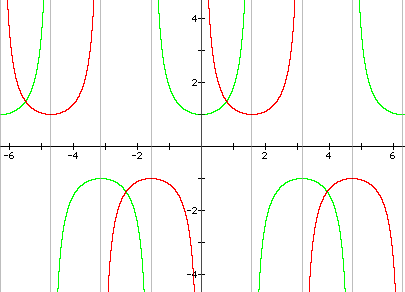
2.

a) The graph moves C units to the left.
b) The graph moves C units to the right.
IV. Here are some sample graphs:
1.
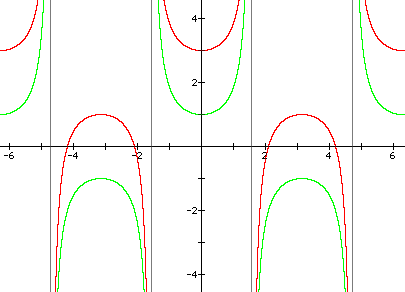
2.
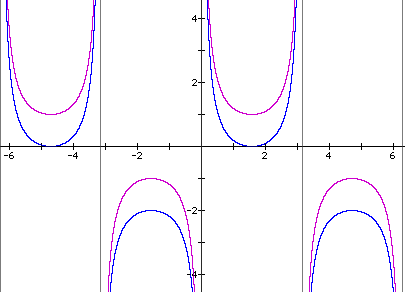
a) The graph moves D units up.
b) The graph moves D units down.
1. Determine the vertical streching/shrinking, period, phase shift, and vertical shift of each function.
a) y = sec3(x - p) + 2
b) y = 2csc4(x + p/2)
c) y = -3cscx - 4
d) y = sec(4x-12p)
2. Graph each function over the interval [-2p,2p] (Remember to graph in stages if necessary).
a) y = 2csc2x
b) y = sec(x - p)
c) y = -secx + 1
d) y = csc(x + p/2) - 2
1.
a) none, pd = 2p/3, ps = p right, vs = 2 up
b) v. stretch = 2, pd = p/2, ps = p/2 left, vs = 0
c) v. stretch = 3, pd = 2p, ps = 0, vs = 4 down
d) (First factor out 4: y = sec4(x - 3p)) none, pd = p/2, ps = 3p right, vs = 0
2.
a)

b)
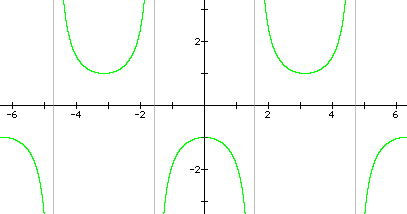
c)

d)
